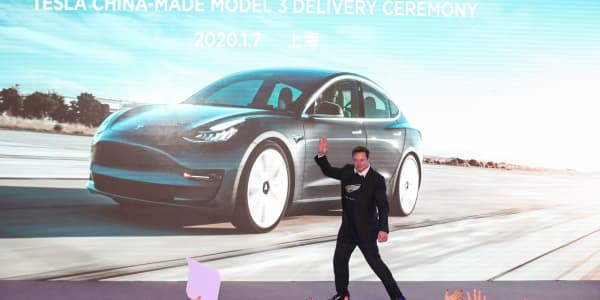It's a nearly religious point among climate-change skeptics, not least among them President Donald Trump: If America moves quickly to reduce carbon emissions, electric bills will spike and business will suffer.
But it's not true, and a handful of leading-edge utilities, far from the liberal confines of California and years in advance of the enactment of a Green New Deal like the one proposed by newly elected Rep. Alexandria Ocasio-Cortez, are showing how a green electricity future can work. Already, carbon emissions from electricity are 28 percent lower than in 2007, according to the Edison Electric Institute, a trade group for investor-owned utilities. And inflation in electricity rates has averaged just 1.1 percent since 2010, by Labor Department figures — lower than the overall inflation rate.
Now the utility industry is targeting the truly big numbers — reductions of 40 percent to 80 percent by 2030, with leaders like Minneapolis-based Xcel Energy, which serves 3.6 million electric customers in eight states from Minnesota to Texas, saying it's possible to go virtually carbon-free by 2050 with little to no rate impact.
The basic notion is that the money used to pay for new wind and solar energy power plants can be financed with cash not spent on coal or natural gas, especially with interest rates so low.
"The surprising thing is that when you do the math, it's cheaper to build the wind and not use your coal and gas plants as much," Xcel Energy CEO Ben Fowke said in a speech in Denver last year. "Most of our customers want a cleaner energy product. All of them want an affordable energy product."
On a path to 80 percent renewable by 2030
The first reason coal began going away has been the falling price of natural gas, but the falling price of renewables is now making coal's woes a one-two punch as wind power becomes the nation's fastest-growing electricity source, according to cost estimates from investment bank Lazard. Switching to gas from coal cuts a utility's carbon emissions by about half, and switching to wind, solar, or hydropower cuts them to zero.
At Xcel, Fowke said the cost of making wind-based power has fallen to $20/megawatt hour from $65 in 2008, while solar power has dropped to $30 from $180. He noted that electricity has never been cheaper, adjusted for inflation, than it is now, and predicted that Xcel's power will be 55 percent renewable by 2026. It wants to reach 80 percent renewable by 2030.
With a picture of stable prices and heavy capital investment, it may be a surprise that Xcel's stock is actually beating other utility shares handily.
The company's shares have risen 78 percent over the last five years — and pay a 2.84 percent annual dividend yield. The company says profits are likely to rise 5 percent to 7 percent annually through 2023 as costs decline despite the capital investment. The Utilities Select Sector SPDR exchange-traded fund, the largest tracking the utility industry, has risen about 38 percent in the past five years.
"The reduction in the cost of renewables and especially natural gas has let them do this," said Emily Fisher, general counsel at the Edison Electric Institute. "Going forward, it will be a different suite of technologies. Xcel's plan is the boldest because they're talking about getting to 100 percent. But they're not alone."
At Xcel, Fowke is overseeing a plan to spend another $20 billion by 2023 to make the company's goals for 2030 and 2050 happen. The company already has reduced its carbon emissions by 35 percent since 2005, while retiring coal plants that once generated 2,100 megawatts of electricity, enough to power 2.1 million homes. By 2021, Xcel plans to own 11,300 megawatts' worth of wind-powered plants, which is 10 times its 2005 total. As it does so, it will also phase out more expensive renewable power it buys from third parties using earlier-generation technology, another important source of cost savings.
In 2012 Fowke characterized many of these moves as a way to get ahead of what he called a "tsunami" of upcoming regulations about mercury, carbon and other pollutants. "We've gotten ahead of the game,'' he said, in part by using tax credits designed to promote wind adoption.
Xcel customer bills are falling
While all this has been happening, the average electric bill at Xcel was falling. The average customer paid $83.52 a month for electricity in 2013, dropping to $81 by 2017. Natural gas bills fell from $61.64 in 2014 to $45.79 in 2017, the company says.
"I think we can do it in a way driven by economics that is pragmatic," Fowke said in Denver.
Xcel is in a unique position — geographically.
"They are blessed with two things unlike any utilities," said Morningstar analyst Travis Miller. "Their territory crosses some of the most wind territories this side of the Himalayas. And that means their cost for wind is substantially less than almost anyone else," he added, cautioning that shares have become richly priced as earnings per share jumped 9.8 percent last year.
Thomas Edison wouldn't recognize today's energy industry. And he definitely wouldn't recognize it in 10 years.Ben FowkeXcel Energy CEO
Similar changes in portfolio mix are occurring across the utility landscape, and not only where wind is at an advantage. Each utility has to shift generation in a different way, depending on local resources.
Southern Co., whose largest subsidiary is Georgia Power and which serves Alabama and Mississippi, was 70 percent reliant on coal as recently as 2007. Once known as a kind of coal king among utilities, that number is down to 27 percent, bringing the Southern's greenhouse-gas emissions down 36 percent.
By 2022, Southern will get 36 percent of its power from carbon-free sources, company spokesman Schuyler Baehman said. Of that, 30 percent will come from solar, 29 percent from nuclear and 19 percent from wind. The company plans to close more coal plants as part of CO2 reduction, a move that CEO Tom Fanning said in his annual letter to shareholders last year was not being driven by regulatory mandates.
To pick up part of the slack as more coal plants close, Georgia Power is adding two reactors to its Vogtle nuclear plant near Augusta. It's one of the few large utilities boosting its nuclear portfolio in an expansion financed partly by loan programs funded in the 2009 federal stimulus bill.
Moves like Xcel's are big enough to begin to address worries about climate change, said Pam Kiely, senior director of regulatory strategy at the Environmental Defense Fund.
"These reductions are consistent, especially the 80 percent by 2030, with what we need to do across the economy, " Kiely said. "They are talking about a level of ambition out of the power sector that is finally consistent with what we need. You've got to begin with the power sector, and now it's an incredibly cost-effective strategy.''
One extreme example of what can be done comes from Iowa, where Berkshire Hathaway's energy subsidiary expects to be producing enough wind-powered electricity by next year to meet all of its customers' electricity use without raising rates. However, because wind power is generated mostly at night, the utility will have other plants available to meet demand when wind is lower, while selling surplus wind power to other utilities over electric grids.
"Thomas Edison wouldn't recognize today's energy industry," Fowke said. "And he definitely wouldn't recognize it in 10 years."





